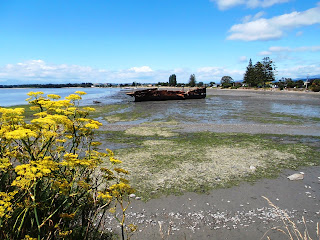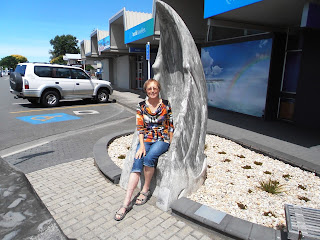 |
| Motueka Beach |
It was not the weather that deterred us the next day but my
dodgy digestive system, playing up as it does from time to time. I suspect it’s
all psychosomatic although to be that there is usually a subconscious cunning
plan beneath it all, and for the life of me I have yet to figure it out.
However, I did try and we ventured beyond the comforts of our little house-on-wheels,
albeit tentatively.
 |
| The remains of the Janie Seddon |
We woke to a glorious day, despite the weird cloud
formations of the previous evening, the type that often bode the coming of poor
weather. We even ventured into shorts and sandals, items that had been stored
away after hanging about on hand just in case, for oh-so long. We drove into
the centre of Motueka, shopped, dumped and picked up regional brochures from
the iSite, then drove to the beach on the northern edge of town, parking near
the wreck of the Janie Seddon, last used to lug coal, beached here in 1955.
Cycle trails abound in the Tasman Bay, including one all along the waterfront
here, and we walked a short distance along to one of the old earth built
wharves and Chris read the information panels.
We lingered for a while trying to gauge the severity of my
ailment, until I convinced my husband that we should proceed as per our Plan A,
on up the coast to Kaiteriteri and beyond. So we drove on through Motueka and
Riwaka, passing orchards and vineyards; apples, apples, everywhere … but not a
one to buy and eat!
 |
| Marahau and the Abel Tasman Track |
Kaiteriteri, fifteen kilometres beyond Motueka, is
supposedly one of New Zealand’s most beautiful beaches, a sheltered bay of
white sands with cafes, motor camps and motels to cater for visitors. There are
also extensive car parks but never enough, hence we have never actually stopped
there and walked about to savour the wonders for ourselves. Both our
drive-throughs have occurred at the peak of summer (or the time summer is
supposed to occur) and there has never been enough space for us to park; this
is a problem one suffers time after time in England, but who would think little
old New Zealand
could possibly be the
same!.

Instead we continued on over the hill to Sandy Bay,
crossing the estuary on the causeway and arriving at Marahau,
the beginning of the Abel Tasman Track,
another of New Zealand’s Great Walks, this a fifty one kilometre three to five
day trek that can be kayaked in part. We walked just twenty minutes to Stu’s
Lookout then turned back to the busy National Park’s info centre, which again
was left for Chris to explore. It is normally I who spends the time absorbing
all the history and other information on offer, as you will have already
deduced from reading this blog!
 |
| The uninspirational Riwaka Resurgence |
We returned to the main highway via the inland route, no
less winding than the coastal road, but less busy with traffic.
We were keen to revisit the Riwaka Resurgence at the foot
of the Takaka Hill, where the Riwaka River seems to rise from the bowels of the
earth like a great spring. In truth, it flows down through the subterranean
channels between the limestone caverns that honeycomb the Hill. When we came
ten years ago, we were fascinated by the crystal clear water in the pool at the
point of resurgence. There were many others here all standing about the rocks
in the bush marvelling at this geological wonder and the magic of the place,
apparently respected by Maori, was contagious. So much so in fact that a couple
of lovely young foreign women stripped down to their skin and dived into the
sacred waters, adding to the whole inspirational scene. Perhaps “inspirational”
is not the word that the male members of the audience felt; that I leave to
your imagination.
 |
| Baring legs in sunny Motueka |
Alas yesterday there were no water nymphs, or crystal clear
water,
only steel platforms, barriers
and stairs above a murky hole that was anything but inspirational. It was
altogether a disappointment, in fact we wondered if we were even at the same
spot.
In its favour however, credit must be given to DOC or the regional
wombles who have redeveloped the parking and picnic areas. It is a charming
spot to come and laze beside the river, for children to pick their way about
the river stones and to offer oneself to the sand-flies for desert.
On the drive up the valley road we had noted a reserve and
a few motorhomes parked up, so on our return, we called in to check the situation
out. Here we found an ideal spot to overnight, free parking for self-contained
vehicles together with a dubious long-drop toilet and a river full of water to
serve all one’s needs.
 |
| Pretty St Thomas Anglican Church in main street Motueka |
This morning I woke to the chorus of bellbirds, the call of
wekas somewhere up in the bush and yet another sunny day, and best of all no
sign of yesterday’s niggles. After breakfast we headed back east to Nelson, a
distance of some sixty kilometres and had the cover of our 240vt power hatch
which had arrived from Christchurch, installed. This was done efficiently for
an incredibly modest fee; we have yet to receive the bill for the replacement
part.
Happy to have the repair done, we returned to our little
spot here up the Riwaka valley, after stopping en route in Motueka. There we
wandered at leisure up and down the street, spending our cash here and there; a
bottle of wine, three books, a new belt, a set of replacement coasters, the latter
items from the Hospice Shop. We became quite attached to charity shops in
Australia when we were travelling there and although they are not as numerous
here as they are in Australia and England, they are always worth checking out.



 Instead we continued on over the hill to Sandy Bay,
crossing the estuary on the causeway and arriving at Marahau, the beginning of the Abel Tasman Track,
another of New Zealand’s Great Walks, this a fifty one kilometre three to five
day trek that can be kayaked in part. We walked just twenty minutes to Stu’s
Lookout then turned back to the busy National Park’s info centre, which again
was left for Chris to explore. It is normally I who spends the time absorbing
all the history and other information on offer, as you will have already
deduced from reading this blog!
Instead we continued on over the hill to Sandy Bay,
crossing the estuary on the causeway and arriving at Marahau, the beginning of the Abel Tasman Track,
another of New Zealand’s Great Walks, this a fifty one kilometre three to five
day trek that can be kayaked in part. We walked just twenty minutes to Stu’s
Lookout then turned back to the busy National Park’s info centre, which again
was left for Chris to explore. It is normally I who spends the time absorbing
all the history and other information on offer, as you will have already
deduced from reading this blog!


No comments:
Post a Comment